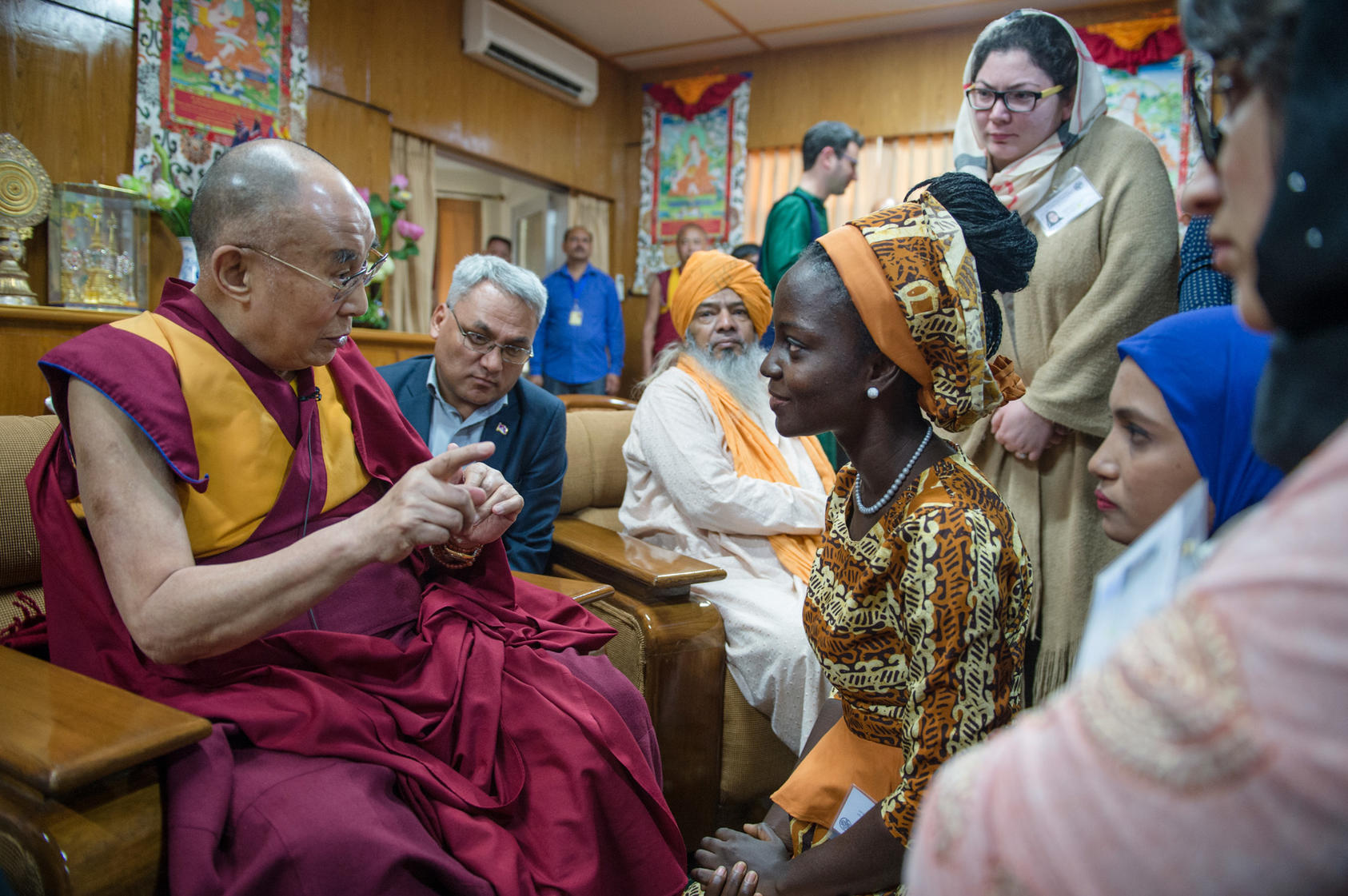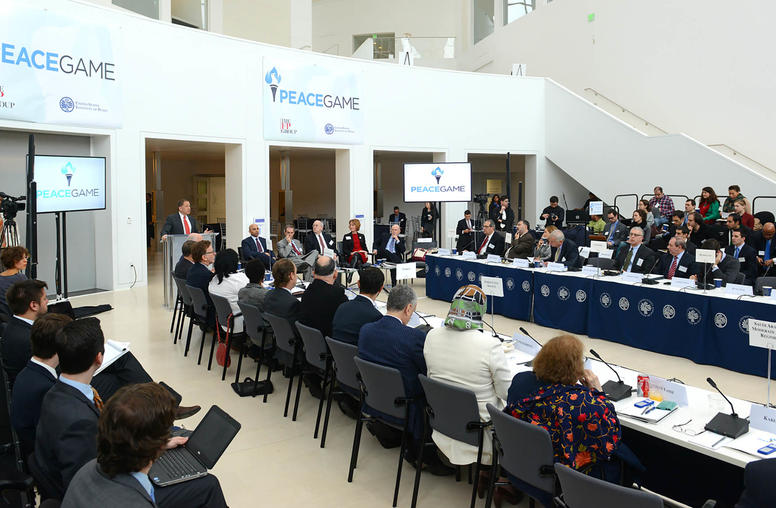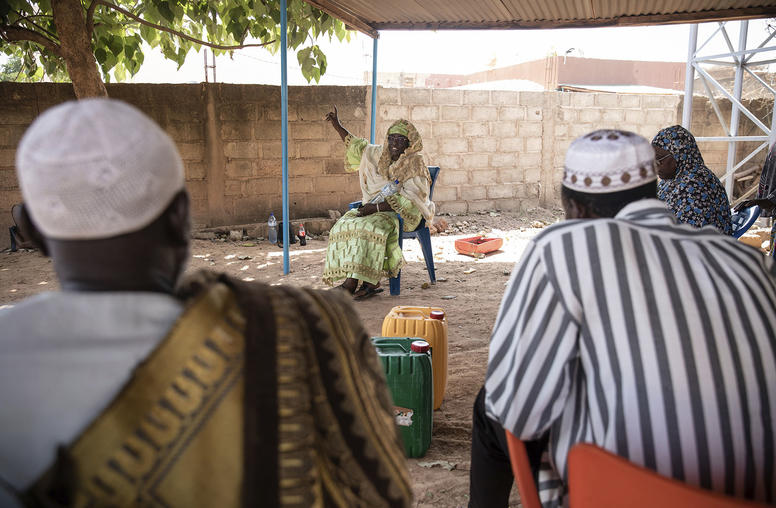Violent conflict, often shaped by religious extremism, is concentrated in many of the world’s youngest populations, underscoring that a more peaceful world cannot be built without youth helping to lead. Five months after the United Nations formally urged governments to act on that idea, 28 young peace leaders from countries facing violence and extremism met the Tibetan Buddhist spiritual leader, the Dalai Lama, to work on making it happen.
The U.S. Institute of Peace “brought youth leaders from 13 countries affected by violent extremism, conflict and civil war" to India to meet the Dalai Lama, said USIP President Nancy Lindborg. "Our goal is to support a growing global network of youth leaders working to advance peace by providing them with practical skills, a sense of community and the personal resilience that is so essential when working on difficult issues in difficult places." At his residence in the Himalayan foothills town of Dharamsala, the Dalai Lama heard the peace leaders’ stories, offered encouragement, personally served them cookies—and pressed them to deepen their empathy for others as they work.
The Dalai Lama underscored the need for all peacebuilders to strengthen their personal “love and compassion, forgiveness and tolerance,” said Victoria Ibiwoye, 22, a Nigerian law graduate from Lagos who leads a program to educate and encourage children, notably from poor communities, as citizens. “Putting our religions or different ethnic groups aside, we all speak the same language when it comes to … compassion,” said Ibiwoye during a webcast panel discussion with specialists on peace and conflict.
“He really challenged me as a youth by saying that we are our own masters. Sometimes we are expecting the solution to come from elsewhere, to come from government, to come from leaders, to come from the sky. But we have to be able to provide solutions,” said Ibiwoye, who has been a fellow in USIP’s Generation Change program.
The Dalai Lama, a Nobel Peace Prize recipient who is now 80, was thrust into the leadership of the Tibetan people at age 15 as they faced the traumas of a war with China. Since he was 24, he has lived in exile. He repeatedly underscores the critical role of young people in building peace, and holds teaching sessions with youth.
Meeting with the USIP-convened group—whose members came Afghanistan, Egypt, India, Iraq, Kenya, Morocco, Myanmar, Nigeria, Somalia, South Sudan, Sudan, Tunisia and Uganda—the Dalai Lama asked the group to stay for several hours beyond the scheduled sessions, spending nine hours with them over two days.
The Dalai Lama, who often jokes about his advancing age, said the activists "make me want to live longer” to see their achievements.
No Peace Without Youth
The most violent conflicts are being fought, and extremist groups are growing, within the world’s most youthful populations: In the five countries that suffered nearly 80 percent of recent deaths from violent extremism (Syria, Iraq, Afghanistan, Pakistan and Nigeria), half of all people are younger than 22. In recent years, the world has been growing more violent and more young. Deaths worldwide in conflicts reached 180,000 in 2014, more than triple the level in 2008. And a quarter of all people—1.8 billion of 7.2 billion—were aged between 10 and 24 years in 2014, says the U.N. Population Fund.
Globally, “there’s a shift happening. The international community has been recognizing that we cannot just see young people as … victims or perpetrators of violence,” said Saji Prelis, the director of youth programs at Search for Common Ground, an organization that works to resolve violent conflicts. “We have to see these 1.8 billion young people as an asset and as part of the solution.”
The imperative of strengthening peacebuilding by youth was reinforced in December by the U.N. Security Council. In its Resolution 2250, the council urges governments to include youth in peace processes and in the wider “peacebuilding” campaigns for tolerance and social justice that can turn countries away from violent conflict and extremism.
The USIP-convened youth leaders “are special, [but] they are not unique,” said Prelis in yesterday’s panel discussion. “There are millions of young people just like them” who are actively strengthening justice and stability in their communities, and who should have a larger voice in the global peacebuilding effort.
The Rider and the Elephant
Participants in Dharamsala discussed the particular threat to youth posed by extremist religious groups such ISIS in the Middle East and Boko Haram in Africa’s Sahel region. The most effective opponents to such radicalization of young people are other young people, said Soukaina Hamia, a leader of IDMAJ, an association that mentors children and builds communities in the slums of her hometown, Casablanca, Morocco.
“The extremist groups—they are recruiting … teenagers and youth in their early 20s,” Hamia said in the panel discussion. “So we need youth to play this role” of countering the radicalization, because “they understand” the young people being targeted. “They know their needs and they speak the same language.”
Emile Bruneau, a neuroscientist from the Massachusetts Institute of Technology, noted that research, including high-tech imaging of the brain at work, is helping to reveal the mechanisms human decision-making, including the acceptance of radical, violent ideas. He compares the brain to a rider on an elephant, with people able to consciously manage only the actions of the rider, while the elephant is a more powerful subliminal force that we may be able to train—but neither fully understand nor control.
Much of what conditions our ability to empathize with people—or to dehumanize or even physically attack them—is our attachment to a group identity, Bruneau said. A strong attachment to “our own” group often makes it harder for us to empathize with people perceived as “other.” Still, if “unconscious biases … might be driving individuals into conflict,” the hopeful news is that the brain is highly flexible, he told the group.
“You can gain conscious control over these unconscious processes. … Nothing is set in stone,” Bruneau said. “One of the reasons I’m really excited to be here is that Tibetan monks are the first applied neuroscientists. They’ve shown us what’s possible” in gaining “conscious control over our unconscious processes.”
Dalai Lama: Begin with the Self
The Dalai Lama stressed the need for “constant introspection” to build a “universal empathy” that offers compassion equally to all people, Bruneau noted. For a discussion with the youth leaders on interfaith dialogue, the Dalai Lama invited Muslim leaders, including one of India’s senior sufi clerics, Syed Zainul Abedin, to come to Dharamsala to take part.
In his meetings with the USIP-convened group, the Dalai Lama underscored the need for peacebuilding to begin spiritually, stressing “the importance of developing [a] sense of oneness and internal disarmament,” according to Phayul, a Tibetan online newspaper in Dharamsala that covered the event.
“I loved how His Holiness … gave us time and space to reflect and see clearly what I want to be and what I want to do,” said Hamia, the Moroccan youth leader. “I’m looking forward to experience life with this fresh perspective,” she said in the panel discussion. “I got to understand more that conflict can be an opportunity to grow, to be a better person, for me and for others.”
“The Dalai Lama said this morning that he was encouraged by meeting with this group,” said Washington Post columnist Michael Gerson, who attended several of the meetings and moderated the panel discussion. “So it wasn’t just they who were encouraged by meeting with him. And I think that’s really extraordinary.”




